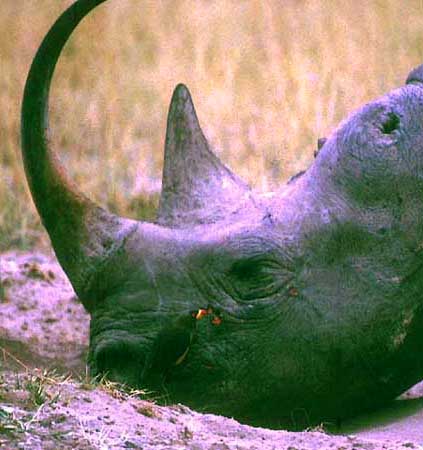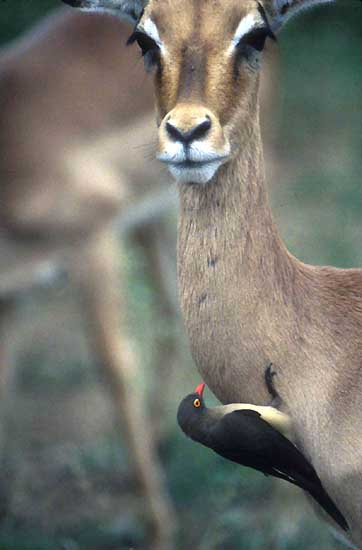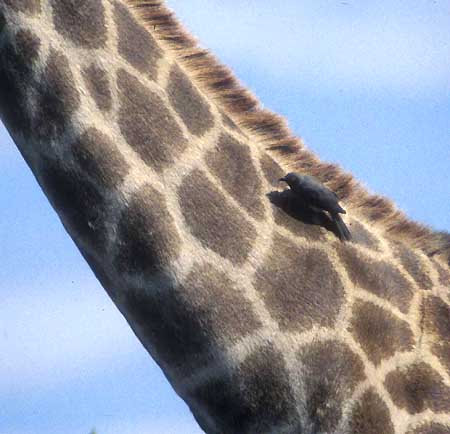

 The two species of Oxpeckers are broadly distributed across sub-Saharan
Africa where they are obligate commensals with large African mammals. They
forage in small flocks on large mammals eating ticks, fleas and flies but
also consuming wound tissue, blood and other secretions. They are thus
considered to be semi-parasitic. They often favor large ungulates; the
Red-billed
Oxpecker (left) is working through the necks hair of an Impala.
Where the Red-billed Oxpecker overlaps with Yellow-billed Oxpecker (mostly
in East Africa) the Red-billed especially prefers the manes of Giraffe
(below) while the Yellow-billed prefers thinner-haired beasts like buffalo
or rhino.
The two species of Oxpeckers are broadly distributed across sub-Saharan
Africa where they are obligate commensals with large African mammals. They
forage in small flocks on large mammals eating ticks, fleas and flies but
also consuming wound tissue, blood and other secretions. They are thus
considered to be semi-parasitic. They often favor large ungulates; the
Red-billed
Oxpecker (left) is working through the necks hair of an Impala.
Where the Red-billed Oxpecker overlaps with Yellow-billed Oxpecker (mostly
in East Africa) the Red-billed especially prefers the manes of Giraffe
(below) while the Yellow-billed prefers thinner-haired beasts like buffalo
or rhino.

The Yellow-billed Oxpecker (below left in a nice shot by Dale & Marian Zimmerman) differs from Red-billed by its swollen yellow base to the bill but also by a pale rump, visible at a long distance. This Yellow-billed Oxpecker is pecking at wounds on a rhino (which was missing an ear and known back in 1960s as "Pixie" in Amboselli; by the time I got to Amboselli in the 1980s rhinos were almost extirpated and I never saw even one). Both species forage on Cape Buffalo; these are Red-billed Oxpeckers on Cape Buffalo (below right) in Kruger National Park, South Africa.


Many authorities, including the recent family book by Feare & Craig (1999), consider oxpeckers to be a subgroup of starlings [Sturnidae]. Sibley & Ahlquist (1990) and Sibley & Monroe (1990) consider them simply a tribe of the Sturnidae based on their biochemical analysis. But the recent volume in the Birds of Africa series (Fry & Keith 2000) separate them as a separate family [Buphagidae] and their reasons resonate with my inclinations and I thus follow their lead. They write:
"They certainly originated as starlings, and have the same feather melanin granule structure as many other starlings; oxpeckers also have the same scissoring movement of jaws and similar jaw musculature as Asian starling Scissirostrum dubium. However, in our opinion their distinctions from true starlings (foot and tail morphology, foraging behaviour, incipient or actual parasitism) are too great for acceptable accommodation in a single family. Association with large mammal hosts runs deep into oxpeckers' lives: they travel with the herds, feed almost exclusively on their ectoparasites, rest and preen, court and copulate on them and may sleep on them at night, and pluck their fur and use their dung to make their nests. Recognizing that this commensal or semi-parasitic association is developed to an unique degree amongst birds worldwide, with distinctive behavioural, reproductive and morphological adaptations, we follow those authorities who raise the oxpeckers to family rank."Some of the recent field guides (e.g. Sinclair et al. 1995) also treat the Oxpeckers as a distinct family but a good many (e.g., Zimmerman et al. 1996) do not.
Oxpeckers are gregarious and breed semi-colonially and cooperatively. They have been much-studied and there is an extensive bibliography cited in both Feare & Craig (1999) and Fry & Keith (2000). They have also suffered persecution in the past (there was once much debate in the literature on whether oxpeckers were "valuable" and had an economic benefit or detriment to hunters and stockman) and disappeared -- as did many large mammals -- from many places in their original range. Efforts to re-introduce the Yellow-billed to parts of South Africa seem to be succeeding, and that species as re-colonized Kruger National Park (but Red-billed is still much more the common species there, as shown in this set of photos).
For myself, I just think oxpeckers are very cool to watch as they swarm over the large mammals of Africa.
Photos: All the photos of Red-billed Oxpecker Buphagus erythrorhynchus were taken in July 1996 in Kruger Nat'l Park, South Africa. The shot of Yellow-billed Oxpecker Buphagus africanus was taken by Dale & Marion Zimmerman in Amboselli Reserve, Kenya, in June 1966. Photos © 2000 by Don Roberson and Dale & Marion Zimmerman, as detailed above; all rights reserved. The photo by the Zimmermans is used with permission.
Bibliographic note
Family book: rating HHHH [out of 5
possible]
Feare, Chris & Adrian Craig. 1999. Starlings and Mynas. Princeton
Univ. Press, Princeton, N.J.
This is another in the standardized family books released by a variety of publishers. The now familiar layout has color plates facing maps and brief text up front and detailed species accounts in the back. The plates by Barry Croucher, Chris Shields and Kamol Komolphalin are attractive and sometimes contain a bit of background; they are more in a handbook style layout rather than field guide plates and, mostly, I like them. A good job was done with gloss on various starlings. The text seems thorough and has mostly been well-reviewed in the literature I've seen. The introduction leans heavily towards explaining the various limits of the genera, and only the briefest bits on ecology or biology. The species text is weighted to detailed plumage descriptions when I would have preferred more emphasis on interrelationship with habitat and behavior and calls. But it seems fine in what has become the now traditional style.Another very good introduction are the seven Buphagidae pages in Fry & Keith (2000). I very much like the line drawings scattered in this text showing interactions with large mammals.
The Oxpeckers are treated as just a tribe of the starlings. The text for the oxpeckers is somewhat more lengthy than for many species (8 pages for the two species) and covers biology in much greater depth, providing a fine introduction
Other literature cited:
Fry, C. H., and S. Keith, eds. 2000. The Birds of Africa. Vol. 6. Academic Press, London.TOPSibley, C. G., and J. E. Ahlquist. 1990. Phylogeny and Classification of Birds: A Study in Molecular Evolution. Yale Univ. Press, New Haven, CT.
Sibley, C. G., and B. L. Monroe, Jr. 1990. Distribution and Taxonomy of Birds of the World. Yale Univ. Press, New Haven, CT.
Sinclair, I., P. Hockey, and W. Tarbotan. 1993. Illustrated Guide to the Birds of Southern Africa. New Holland Ltd., London.
Zimmerman, D. A., D. A. Turner, and D. J. Pearson. 1996. Birds of Kenya and northern Tanzania. Christopher Helm, London.